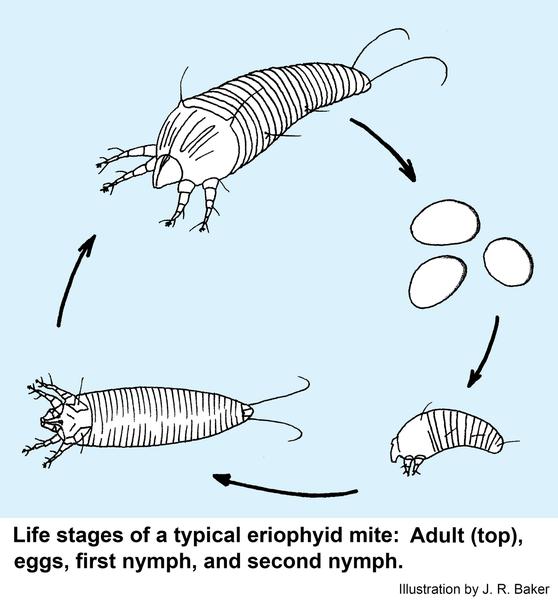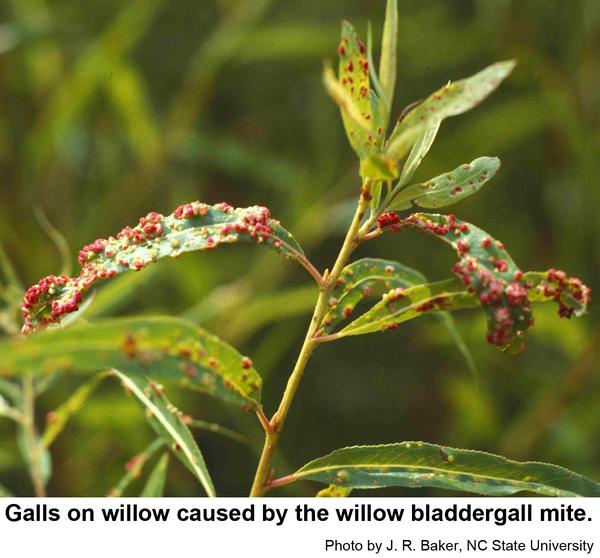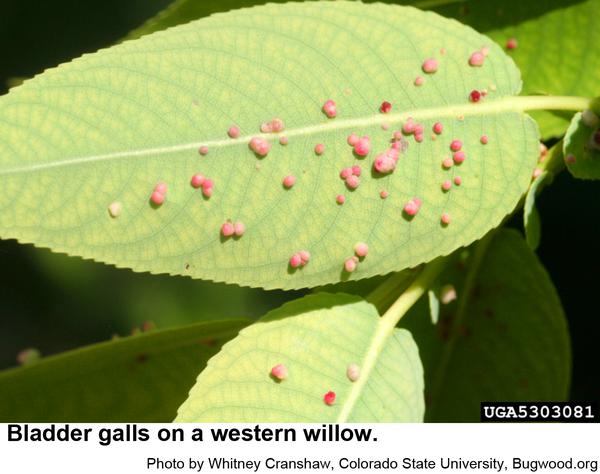Description and Biology
The willow bladdergall mite, Aculops tetanothrix, is an eriophyid mite that causes tiny, hollow galls on willow. These mites are virtually microscopic (0.2 mm long) and have two pairs of legs at the front. Reddish willow bladdergall mites overwinter on the bark and under bud scales of willow and in spring crawl to the new, tender leaves just as the new growth emerges from the buds. (After the leaves have fully expanded, the mites can no longer induce gall formation.) They feed on the lower surface and cause leaf cells on which they feed to become swollen and to bulge up into a tiny balloon-like structure. The gall protects the mites from the environment and predaceous insects to some extent. Females lay eggs that develop into white bladdergall mites that feed and induce the plant to maintain the bladder galls in which the mites grow and reproduce. Eventually, the gall "matures" and is no longer suitable for the mites. By that time the mites have given rise to a generation of reddish mites that are able to survive outside the galls. The rest of the growing season, fall and winter are spent on the bark, in bark crevices, and wedged into bud scales. The galls are not likely to cause any real injury to pussy willow, and these mites will not infest any other kind of ornamental plant that is not a willow.
Host Plants
Apparently several of the 400 species of willow (Salix) are suitable hosts for the willow bladdergall mite including black willow, pussy willow, and Ward's (Carolina) willow.
Residential Recommendations
In general, eriophyid mites are sensitive to Sevin insecticide. If there is real interest in preventing gall formation next year, control measures can be directed against the overwintering mites. Spraying this season while the bladder galls are fresh probably won't kill the mites inside, and spraying won't make the galls disappear, either. Infested trees can be sprayed with Sevin at the rate for caterpillar control any time after the galls change to brown or black. Other insecticides available in big box stores that are labeled for residential landscape use should control the mites as well.
Other Resources
- An Illustrated Guide to Plant Abnormalities Caused by Eriophid Mites in North America. Keifer, H. H., et al. 1982. USDA ARS Agr. Handbook No. 573. 178 pages.
- NC State Extension Plant Pathology Publications
- NC State Horticultural Science Publications
- North Carolina Agricultural Chemicals Manual
For assistance with a specific problem, contact your local Cooperative Extension center.
This factsheet has not been peer reviewed.
Publication date: July 10, 2020
Reviewed/Revised: May 7, 2025
Recommendations for the use of agricultural chemicals are included in this publication as a convenience to the reader. The use of brand names and any mention or listing of commercial products or services in this publication does not imply endorsement by NC State University or N.C. A&T State University nor discrimination against similar products or services not mentioned. Individuals who use agricultural chemicals are responsible for ensuring that the intended use complies with current regulations and conforms to the product label. Be sure to obtain current information about usage regulations and examine a current product label before applying any chemical. For assistance, contact your local N.C. Cooperative Extension county center.
N.C. Cooperative Extension prohibits discrimination and harassment regardless of age, color, disability, family and marital status, gender identity, national origin, political beliefs, race, religion, sex (including pregnancy), sexual orientation and veteran status.



